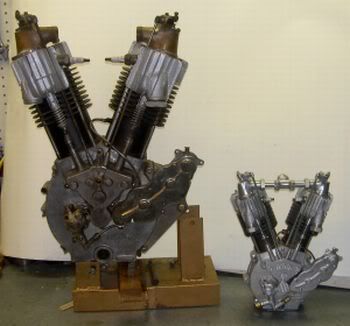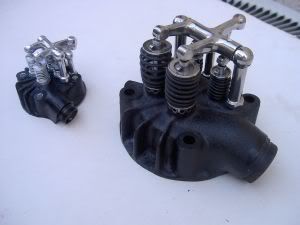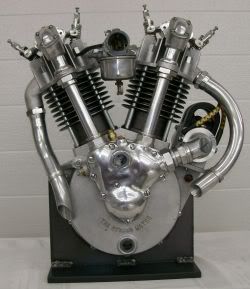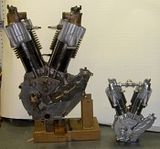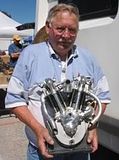Kirk, yes I made a fopah, I believe that Dick Winger, who owned 6 or 7 yes twenty-inch 1/2 scale BTR's are on display in the Winger family private museum.
Interested in these half scale BTR's read this below! You can also go straight to Ed Youngbloods Motohistory and read even more about Dick Winger and his half scale BTR's!
Quoted from "Motohistory"
Dick Winger has taken the replication game in another direction, toward miniaturization. We have previously reported on half-scale Indian engines that Winger has brought to AMCA national meets
(See Motohistory News & Views 3/4/2004, 4/25/2005, and 9/9/2005). First it was a Hedstrom twin, then an Indian eight-valve, both fabricated by Tom Sieber. This time, Winger showed up at Davenport with a complete miniature Indian racer assembled around his tiny eight-valve engine.
He reports that while Sieber can offer copies of the 50% scale Hedstrom, only one eight-valve miniature has and will be built.
In 2000, the Wingers built a 4,000 square-foot facility on their property to house their own collections. We visited shortly thereafter, then returned recently to see how things had changed. The building behind the Winger's home in Sweetster is not just a motorcycle storage barn. It is climate-controlled, nicely appointed, tidy, and well-organized as a private museum. Though it is not open to the public, the Wingers are proud to share it with friends who appreciate our history and heritage.
Very sad the passing of an amazing person!
Richard “Dick” Winger died of cancer Monday May 17th
2010 at 1:00 a.m. Dick had been at the Methodist Hospital in
Indianapolis and started radiation treatments. He came back
to Sweetser, Indiana, on May 3. Condolences may be sent to
Wanda Winger, P. O. Box 333, Sweetser, IN 46987. Memorial
contributions may be made to The Antique Motorcycle Foundation
in care of: Raven-Choate Funeral Home, 1202 Kem
Road, Marion, IN 46952.
Dick Winger was a long time dedicated AMCA member. He
was the AMCA Membership Director and served for 24 years.
Dick was an AMCA Honorary Member. He was the president
of the Maumee Valley Chapter. Dick will be greatly missed.
Our thoughts and prayers are with Wanda and Family.
Richard was born on June 5, 1935, in Grant County, Pleasant
Township, the son of the late Bechtel and Esther (Butler)
Winger. On October 5, 1974, he married Wanda Cavins. She
survives.
He was a member of the Indiana Army National Guard. He
was a telephone engineer, and was Owner and President of
Sweetser Telephone Co. until his retirement in 1998.
I meet Dick in 1998 while working for the Excelsion-Henderson
Motorcycle Company. Dick had already been involved
with the Hanlon’s as a historical advisor for the brand. His stories,
wisdom and wit were wonderful and I truly enjoyed his
company on many occasions, even if I was an “Indian guy”.
Richard was known worldwide as an expert in antique
motorcycles and was Curator of Yesterdays Wheels, a transportation
museum in Sweetser. He was an honorary member
of the Antique Motorcycle Club of America; and was a board
member of the A.M.C.A. and the Antique Motorcycle Foundation.
He was also a member of the Indian 4 Cylinder Motorcycle
Club; President of the Maumee Valley Chapter A.M.C.A.,
a member of the Ohio Valley Chapter A.M.C.A.; Sons of the
Union Veterans of the Civil War; the Pierce Arrow Society
and the Antique Automobile Club of America. He was also a
member of the Converse F&AM Lodge #601; the Ft. Wayne
Valley of Scottish Rite; the Mizpah Shrine and the O.E.S. of
Okemos, Michigan.
Survivors include, wife, Wanda Winger of Sweetser, Indiana;
son, Scott Winger (Vicki) of Sweetser,
Indiana; step-son, Steve Sovey (Kelly)
of Newport, Michigan; step-daughter,
Lisa Sovey of Newport, Michigan; sister,
Pamela Sims of Peru, Indiana; 8 grandchildren
& 5 great-grandchildren.
Hi SB,
I believe you maybe confusing Dale Walksler’s “ Wheels through time Museum”
Home*-*Wheels Through Time in Maggie Valley North Carolina and the National Motorcycle Museum
National Motorcycle Museum | Home in Anamosa Iowa...?
-Kirk
I hope everyone enjoys this history about the man Dick Winger and his half scale BTR's!
C.H.
